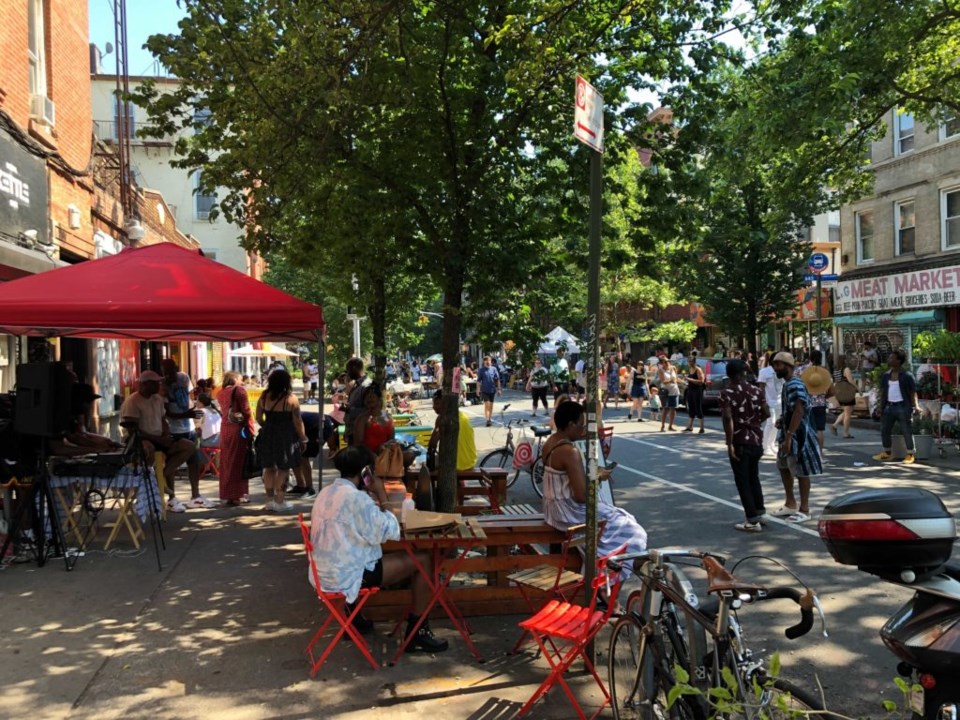Mayor-elect Eric Adams and the City Council must create 10,000 new Black- and Latino-owned businesses over the next five years and improve support systems for existing small business owners of color to ensure an equitable recovery from the pandemic, a new report from economic equity think tank Center for an Urban Future finds.
The report, No Small Relief: Strengthening NYCâs Most Vulnerable Small Businesses, sets out ten policy ideas for helping the cityâs minority-owned businesses make a full recovery from the COVID-19 pandemic, with a focus on supporting new BIPOC entrepreneurs and investing in neighborhood-based small business services that help existing minority-owned firms become stronger, more competitive and more resilient.
Multiple recommendations are focused on expanding neighborhood-level assistance for small businesses in low-income communities that have few small business support resources, including building new infrastructure to support commercial districts that donât have BIDs and to create neighborhood-level, post-pandemic marketing campaigns to promote local shopping, dining and services.
Oma Holloway, senior program director at Bridge Street Development Corporation, said there needed to be more investment at the local level to help support businesses in doing some of the media and marketing campaigns.
âWe are really depending on local residents to keep supporting small businesses,â Holloway said. âWe need broader campaigns to keep people patronizing local businesses.â
Lynette Battle, the deputy director of the Bedford-Stuyvesant Gateway BID, added that during the height of the pandemic last summer her team walked door-to-door to help businesses learn about and sign up for the Paycheck Protection Program and the Economic Industry Disaster Loan programs.
âPeople assume that business owners are hearing about all these programs but we were approaching owners who had no clue,â Battle said.
âTo do this grassroots work it has to be funded to provide the capacity to help.â
The reportâs recommendations were based on three key research findings, CUF says, including that prior to the pandemic, fewer than 10% of New York Cityâs businesses were owned by Black and Latino New Yorkers, despite making up over half of the city's population. Those numbers are likely considerably lower today, following a year in which minority-owned businesses were hit hardest by the COVID crisis, the center added.
Second, many of the cityâs existing minority-owned businesses were financially fragile before the pandemic and the cityâs average minority-owned business generated less than half the revenue of the average white-owned business. âStrikingly few of them had built up e-commerce capabilities or taken advantage of online marketing opportunities,â the report states.
Lastly, few of New Yorkâs minority-owned businesses benefited from city-supported business assistance programs prior to the pandemic, the center said.
Daniel Murphy, the former executive director of the Pitkin Avenue Business Improvement District in Brownsville, said most business training was âjust a one-way dog-and-pony show.â
âWhat we should be doing is sending in specialists to hold their handsâ"to help them tailor a plan and support them through it.â
Local Development Corporation of East New York Womenâs Business Center Director Camile Newman-Alleyne said she had been shocked by how much help the businesses need after walking the streets of East New York with a small team to visit with bodegas and other retailers in the community during the pandemic.
The key recommendations for the City in the report include creating 10,000 new Black- and Hispanic-owned businesses by 2026, and increase of 50 percent over the next five years. The report says to meet that goal, the City must implement a series of policies that greatly increase support for aspiring minority entrepreneurs.
Another recommendation would support that through the creation of a Technical Assistance Corps to bring door-to-door counseling to every small business operating in a low- or moderate-income neighborhood by the end of 2022.
The Corps would provide new resources to help expand staff capacity of effective community-based organizations (CBOs) and tap local MBA students, retired business executives and even out-of-school young adults who have lived or worked in these communities, speak the languages of local business owners and have expertise to offer, the report says.
Another recommendation is to create neighborhood-level, post-pandemic marketing campaigns to promote local shopping, dining and services. The city can help with a neighborhood-focused marketing and promotion campaign that makes modest marketing grants to dozens of commercial districts across the city, enabling local entities to design and implement promotional campaigns that they believe will work best for their unique neighborhoodsâ businesses, the report says.
The report also recommends building new infrastructure to support commercial districts that donât have Business Improvement Districts, including funding a part-time staff person to support local merchants along retail corridors that currently lack a BID.
Jonathan Bowles, executive director of the Center for an Urban Future, said the city needed a long-term small business recovery plan that was squarely focused on boosting the smallest, most vulnerable businessesâ" one that supports them on the long recovery ahead and gives them the best chance of coming back even stronger.
âThis will require an enormous push to meet small businesses where they are.â




